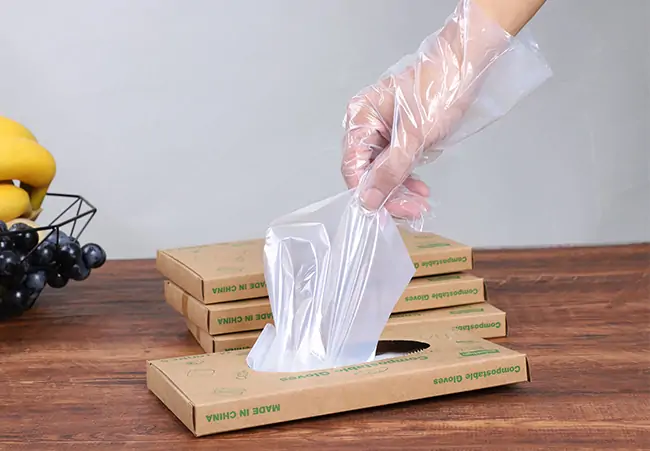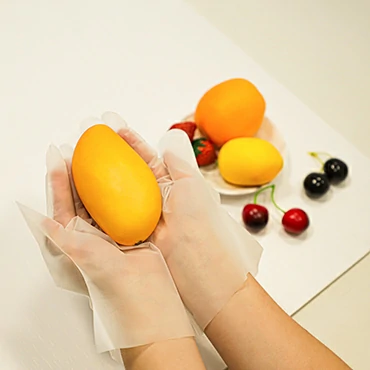
Gloves are a daily necessity, whether you’re whipping up a culinary masterpiece, cleaning the house, or working in a medical facility. But have you ever stopped to think about what happens to those gloves after you toss them? Common plastic gloves can linger in landfills for hundreds of years. That’s where biodegradable plastic gloves come to the rescue, offering a sustainable alternative that protects both your hands and the planet.
But what exactly makes these gloves so special? Let’s dive in!
What are Biodegradable Plastic Gloves Made of?
Forget the image of petroleum-based plastics. Biodegradable gloves are crafted from a completely different breed of material.
The Magic of Plant-Based Polymers
Instead of relying on fossil fuels, these gloves harness the power of plants. They’re made from plant-based polymers, which are essentially long chains of molecules derived from renewable resources like cornstarch and potato starch. Think of it like turning sunshine and plants into something super useful.
Key Ingredients: PLA and PBAT – What You Need to Know
Two of the most common ingredients in biodegradable gloves are:
- PLA (Polylactic Acid): This superstar is derived from fermented plant starch, like corn. It’s biodegradable and compostable under the right conditions.
- PBAT (Polybutylene Adipate Terephthalate): Often blended with PLA, PBAT adds flexibility and strength to the gloves, making them more durable. It’s also biodegradable.
Food-Grade Quality: Safety First
One of the biggest concerns people have about biodegradable materials is safety. Rest assured, high-quality biodegradable plastic gloves are designed to be food-grade. This means they don’t contain any harmful chemicals that could leach into food, making them a safe and reliable choice for various applications.
Why Choose Biodegradable Gloves? (The Environmental Impact)
From Plant to Planet: The Eco-Cycle Explained
The beauty of biodegradable gloves lies in their “closed-loop” system. They start with plants, are transformed into gloves, and then, under the right conditions, break down into natural substances that can nourish the soil. It’s like a continuous cycle of giving back to the Earth.
Breaking Down the Benefits: What Happens When They Decompose?
Unlike conventional plastics that persist for centuries, biodegradable gloves decompose into carbon dioxide, water, and organic matter. This process requires specific conditions like adequate water, heat, and the presence of microorganisms. Think of it as nature’s recycling system!
Reducing Your Carbon Footprint: A Step Towards Sustainability
By choosing biodegradable gloves, you’re actively reducing your carbon footprint. Plant-based materials absorb carbon dioxide from the atmosphere as they grow, and the gloves’ ability to decompose naturally minimizes landfill waste. It’s a small change that can make a big difference.
The Amazing Versatility of Biodegradable Gloves
These aren’t just gloves for eco-warriors. They’re incredibly versatile.
In the Kitchen: Food Service Done Right
-
Cooking, Prep, and Dishwashing: Protecting Your Hands
From prepping ingredients to scrubbing pots and pans, biodegradable gloves keep your hands clean, dry, and protected from hot water and harsh detergents.
-
Maintaining Hygiene: Keeping Food Safe
In professional kitchens, hygiene is paramount. Biodegradable gloves provide a barrier against bacteria and contaminants, ensuring food safety.
In Healthcare: A Barrier Against Infection
-
Medical Procedures: Preventing Cross-Contamination
In healthcare settings, gloves are essential for preventing the spread of infection. Biodegradable gloves offer a sustainable alternative without compromising safety.
-
Protecting Healthcare Workers: A Safety Essential
Healthcare professionals face exposure to various hazards. Biodegradable gloves protect their hands from potentially harmful substances and infectious diseases.
In the Lab: Safety in Scientific Exploration
-
Handling Chemicals: Guarding Against Corrosives
Many lab experiments involve working with corrosive chemicals. Biodegradable gloves provide a crucial layer of protection against skin damage.
-
Ensuring a Clean Environment: Maintaining Accuracy
Gloves are essential for maintaining a sterile environment in the lab, preventing contamination and ensuring the accuracy of experiments.
Around the House: Cleaning with Confidence
-
Dusting, Washing, and Scrubbing: Protecting Your Skin
House cleaning can be tough on your hands. Biodegradable gloves protect your skin from dust, dirt, and harsh cleaning products.
-
Preventing Cuts and Scratches: A Household Essential
Doing housework may come across something sharp that may scratch or cut your fingers. So wearing plastic gloves is even more important.
Biodegradable Gloves vs. Traditional Gloves: A Head-to-Head Comparison

Cost-Effective and Durable: Getting the Most Out of Your Biodegradable Gloves
Worried about the cost? Think long-term!
Tough Enough for the Job: Durability That Surprises
Don’t let the “biodegradable” label fool you. High-quality biodegradable gloves are surprisingly durable and can withstand a good amount of wear and tear. They’re designed to be tough enough for the job at hand.
A Little Goes a Long Way: Maximizing Glove Use
Proper usage can extend the lifespan of your biodegradable gloves. Avoid overstretching them, and be mindful of sharp objects that could cause punctures.
Reducing Waste: Smart Usage Tips
Encourage responsible glove disposal practices. While biodegradable gloves will eventually break down, proper composting or industrial composting facilities can speed up the process.
Food-Grade Biodegradable Gloves: Safe for Food Handling
Let’s talk food safety!

Meeting Safety Standards: What Does “Food-Grade” Mean?
Food-grade means that the gloves have been tested and certified to meet strict safety standards for direct contact with food. They’re free from harmful chemicals that could contaminate your culinary creations.
Direct Contact Confidence: Handling Food Without Worry
With food-grade biodegradable gloves, you can handle food with confidence, knowing that you’re not introducing any harmful substances.
Reassuring Your Customers: Building Trust with Eco-Friendly Practices
In today’s market, consumers are increasingly concerned about sustainability. Using food-grade biodegradable gloves shows your customers that you care about the environment and their health.
Choosing the Right Biodegradable Glove Manufacturer
Finding a reliable manufacturer is key.
Certifications and Standards: Ensuring Quality
Look for manufacturers that hold certifications such as ISO, ASTM, and BPI. These certifications demonstrate that their products meet rigorous quality and safety standards.
Customization Options: Tailoring to Your Needs
A good manufacturer will offer customization options, such as different sizes, colors, and thicknesses, to meet your specific needs.
Pricing and Minimum Order Quantities: Finding the Right Fit
Compare pricing from different manufacturers and consider their minimum order quantities to find the best fit for your budget and business volume.
The Future of Biodegradable Gloves: Innovations and Trends
What’s on the horizon?
Advancements in Materials: Stronger, Faster Degradation
Scientists and engineers are constantly working on developing new and improved biodegradable materials that are stronger, more durable, and degrade more quickly.
Increased Adoption: Growing Awareness and Demand
As awareness of environmental issues continues to grow, we can expect to see increased adoption of biodegradable gloves across various industries.
Conclusion: Biodegradable Plastic Gloves – Protecting Your Hands and the Planet
Biodegradable plastic gloves are more than just a trend; they’re a step towards a more sustainable future. They offer a practical and eco-friendly solution for hand protection in a wide range of applications. By choosing biodegradable gloves, you’re not only protecting your hands but also contributing to a healthier planet for generations to come. So, ditch those old-fashioned plastic gloves and embrace the eco-friendly revolution.
